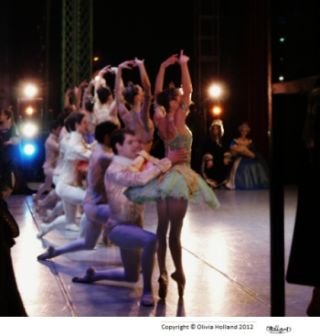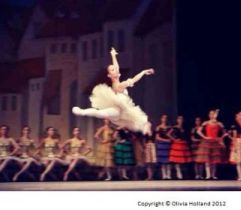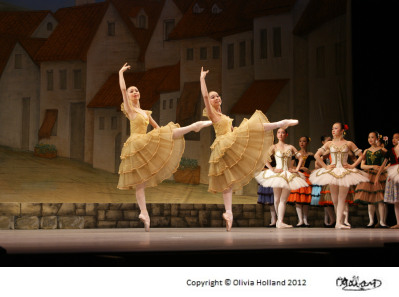Ballet Dance Lesson
The Technical Skills you have to know!
For any ballet dance lesson, you must be aware of the certain skills to help you improve. Ballet has a very demanding technique, but with focus and practice you can work your way to become an even better dancer.
The skills I'm about to describe to you are physical, meaning they are skills YOUR body has to physically do. Don't forget, you can find out the performing skills to achieve mentally here - Perfect Performance Skills.
I will provide you with the most basic yet crucial skills, and then it is up to YOU how to apply it.
In every ballet dance lesson your teacher will most likely be focusing on teaching you these skills.
Now, it is your turn to use own intelligence to become a successful dancer.
Ballet Dance Lesson
Here is everything you need to know for any ballet dance lesson. These are the very top skills, so listen carefully!
Posture Alignment of the spine

The right posture is important for every person, but especially for dancers. It is a crucial part of our training and not only affects every movement or step you take in ballet, but it also helps form the right muscles for your body.
Even the tiniest adjustments, such as tilting your pelvis or having your weight backwards, can absolutely prevent you from mastering a step. In ballet, it is the small details which matter the most.
You must keep your posture straight and always think of keeping your body lengthened. You can imagine there is a string above your head that keeps pulling you towards the sky.
Balance Correct weight placement
If you look at professional ballet dancers, they have incredible balance. Especially when you see the ladies in their pointe shoes, it is like they were born to dance like that!
Yet how do you get that balance? Well, mastering the right balance falls into place with having the correct posture. The two skills work together and enable you to have a strong core stability, allowing balancing to be effortless.

Alignment Having two body parts being in a line with each other
Alignment is one of the key elements in a ballet dance lesson to make sure your overall technique is clean and precise. This would mean having the knees over the toes when in a demi plie, or keeping the leg in front of you when in a tendu devant.
It is these simple
adjustments that are the most important, because if you keep repeating the
wrong type of alignment, it can easily lead to injury. The proper
technique of ballet will make sense if you do it consistently and
correctly.
Co-ordination When the body does two things at once
Co-ordination is important to every dancer, no matter what stage you are at. If you have the right sense of co-ordination, it will allow each movement to be easier and it helps secure those challenging steps.
Lets face it, there's a lot of multi-tasking for dancers because all at once you have to think about each part of your body. I think though, if you really focus on making sure the arms are coordinated, this is what can make al the difference in a ballet dance lesson.
Elevation Reaching a higher level
Elevation
mostly comes into association with jumps, because you always want to attain
height and power in jumps.

Elevation mostly comes into association with jumps, because you always want to attain height and power in jumps. There are dancers who naturally have a higher jumps than others, but it can be improved with time and strengh.
It is a valuable quality for dancers to have good elevation and it can make you stand out from the crowd.
Extra Tip: If you do not have a naturally high jump, you can make it look more powerful by making sure the arms are strong and supported in the air or really travelling through the space.
Strength Physical power and energy
I am sure most ballet dancers strive for the ultimate physical strength. You can never be strong enough and even the most highest of dancers are still practicing to be stronger.
Being strong and having strength is something you can't just pull off in one ballet dance lesson. It isn't just the number of repetitions that increase the strength but the high loads, such as holding the leg in extension.
Strength definitely takes time to build up, so patience and persistence is key.
Stamina The ability to sustain physical exercise
You need a lot of stamina as a dancer in order to push through all those exhausting exercises and still keep strong in your muscles.
You'll find that as your stamina increases you will feel a lot better in your classes, because it will no longer be a struggle to finish a tiring grand allegro or a challenging variation.
You can improve stamina by including a mixture of aerobic exercise such as swimming, running or cycling into your weekly program.

Flexbility Mobility in the joints and elasticity of muscles
You
will see that most dancers are flexible and it comes more naturally to some than others. Mostly, flexibility will be something you
have to really work for.
Flexibility is a skill that has to be approached intelligently when trying to improve. It is easy to overstretch and tear the muscles, so you must stretch on a gradual basis.
You can target your muscles after class when your body is warm, because I always think this is the best time to stretch without injuring yourself.
Mobility The ability to move or be moved freely and easily
Every
dancer tends to have very mobile joints in the feet, ankles and
hip joint. With all the training that you do, your body naturally become
very versatile and you can adjust to all sorts of positions, which ordinary
people would find impossible to do!
Mobility gradually improves with your dance lessons, but I would say you musn't grip your muscles. When you are working really hard, you can tense the muscles too much instead of lengthening.
You must imagine your muscles are like an elastic band, so they are still incredibly strong but able to lengthen and be long.
return from Ballet Dance Lesson to Ballet Dancers Guide homepage or alternatively back to Audition Tips

